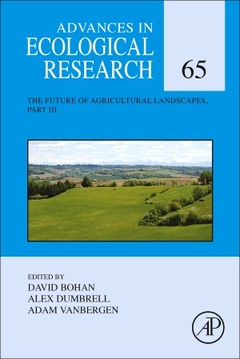Description
The Future of Agricultural Landscapes, Part III
Advances in Ecological Research Series
Coordinators: Bohan David, Dumbrell Alex
Language: English
Subject for The Future of Agricultural Landscapes, Part III:
454 p. · 15.2x22.8 cm · Hardback
Description
/li>Contents
/li>Biography
/li>Comment
/li>
Socio-ecosystems and conflict
1. Conflicts between agriculture and biodiversity conservation in Europe: Looking to the future by learning from the past
2. Building a shared vision of the future for multifunctional agricultural landscapes. Lessons from a long term socio-ecological research site in south-western France
Empirical needs
3. Broadening the scope of empirical studies to answer persistent questions in landscape-moderated effects on biodiversity and ecosystem functioning
4. Promoting crop pest control by plant diversification in agricultural landscapes: A conceptual framework for analysing feedback loops between agro-ecological and socio-economic effects
Global change
5. Designing farmer-acceptable rotations that assure ecosystem service provision in the face of climate change
6. Multiple global change impacts on parasitism and biocontrol services in future agricultural landscapes
7. Harnessing biodiversity and ecosystem services to safeguard multifunctional vineyard landscapes in a global change context
Monitoring
8. Effective biodiversity monitoring could be facilitated by networks of simple sensors and a shift to incentivising results
9. Coupling ecological network analysis with high-throughput sequencing-based surveys: Lessons from the Next-Generation Biomonitoring project
Dave has most recently begun to work with networks. He developed, with colleagues, a learning methodology to build networks from sample date. This has produced the largest, replicated network in agriculture. One of his particular interests is how behaviours and dynamics at the species level, as studied using the carabid-slug-weed system, build across species and their interactions to the dynamics of networks at the ecosystem level.
Dr Alex Dumbrell works at the School of Biological Sciences, University of Essex, UK.
- Provides the authority and expertise of leading contributors from an international board of authors
- Presents the latest release in the Advances in Ecological Research series
- Updated release includes the latest information on the Future of Agricultural Landscapes




